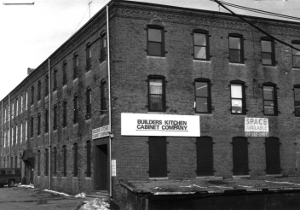Wakefield Rattan Company facts for kids
Quick facts for kids |
|
|
Wakefield Rattan Co.
|
|
 |
|
| Location | 134 Water St., Wakefield, Massachusetts |
|---|---|
| Built | 1889 |
| MPS | Wakefield MRA |
| NRHP reference No. | 89000692 |
| Added to NRHP | July 06, 1989 |
The Wakefield Rattan Company was once the biggest company in the world for making furniture and other cool things from a plant called rattan. It started way back in 1851 in a town now known as Wakefield.
Contents
The Amazing Wakefield Rattan Company
How It All Began
Cyrus Wakefield started this company in 1851. It was located in South Reading, Massachusetts. This town is now called Wakefield. The company became very good at working with rattan. They even made special machines. These machines could weave chair seats and mats.
What They Made
The company made many products. They created beautiful wicker furniture. They also made baby carriages. They were smart about using all parts of the rattan plant. Even the small shavings were used. They turned them into fabric for packaging and floor coverings. Their products were sold all over the United States.
A Town's New Name
Cyrus Wakefield was a very important person in his town. In 1868, he gave a brand new town hall to South Reading. Because of his generosity, the town decided to change its name. They renamed themselves Wakefield to honor him. Cyrus Wakefield also invested a lot of money in the town. He helped it grow and become better.
Growing Big
By 1873, the company was huge. This was the year Cyrus Wakefield passed away. The company had 1,000 workers. Their factory covered a large area, about 11 acres. In the 1890s, the company joined with another company. It became known as the Heywood-Wakefield Company. The factories in Wakefield were updated. This happened after several fires caused a lot of damage.
The End of an Era
By 1930, the company's business had slowed down. The factory buildings were then used for other things. In 1972, a big fire destroyed most of the buildings. Only four buildings were left. In 1989, these remaining buildings were added to the National Register of Historic Places. This means they were recognized as important historical sites. However, in 2005, these buildings were torn down. A supermarket was built in their place.



